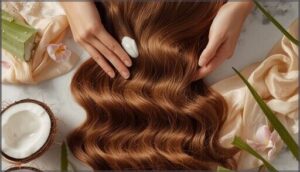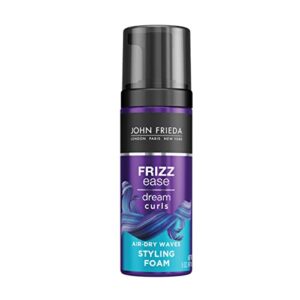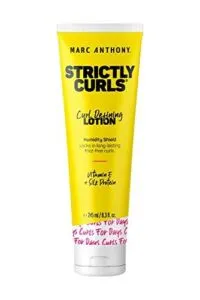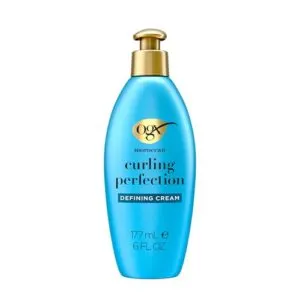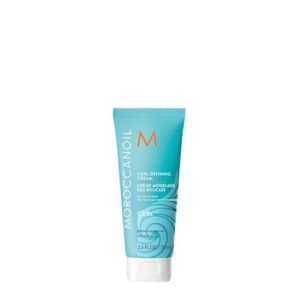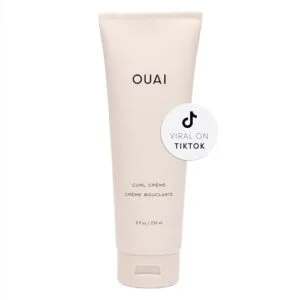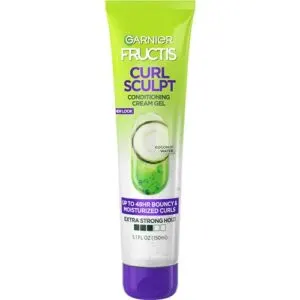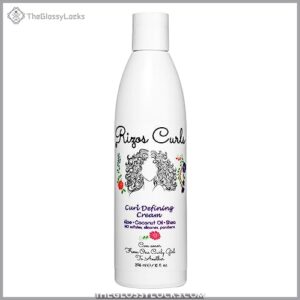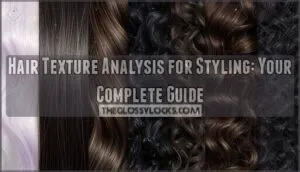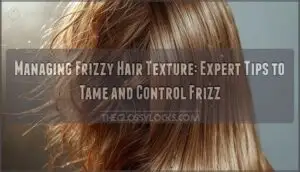This site is supported by our readers. We may earn a commission, at no cost to you, if you purchase through links.

Your hair doesn’t quite straighten when you blow-dry it, but it doesn’t spiral into ringlets either. Instead, it settles into those frustrating in-between waves that seem to have a mind of their own—smooth at the roots, wavy through the mid-lengths, possibly frizzy at the ends.
This textural ambiguity leaves millions struggling with products designed for curls that are too heavy or formulas for straight hair that fall flat. Understanding wavy hair texture isn’t about forcing your strands into a category they don’t belong in.
It’s about recognizing the unique S-shaped patterns that emerge from your follicles, identifying whether you’re working with 2A, 2B, or 2C waves, and learning how factors like porosity and strand diameter shape your hair’s behavior.
Once you decode your hair’s natural language, you’ll discover the care strategies and products that finally make those waves work with you instead of against you.
Table Of Contents
- Key Takeaways
- Defining Wavy Hair Texture
- Classifying Wavy Hair Types
- Factors Affecting Wavy Hair Texture
- How to Identify Wavy Hair Texture
- Best Care Practices for Wavy Hair
- Top 10 Products for Wavy Hair
- 1. Frizz Control Curl Styling Foam
- 2. Curl Defining Styling Lotion Cream
- 3. Natural Wavy Hair Styler Cream
- 4. OGX Argan Oil Curl Cream
- 5. Pacifica Curl Defining Hair Cream
- 6. Moroccanoil Curl Defining Hair Cream
- 7. Curl Defining Hair Cream Product
- 8. Curl Sculpt Conditioning Cream Gel
- 9. Curl Defining Cream For Hair
- 10. Curl Boosting Mousse For Hair
- Frequently Asked Questions (FAQs)
- Conclusion
Key Takeaways
- Wavy hair forms through oval-shaped follicles that create distinct S-patterns, falling into three subtypes—2A (loose waves), 2B (defined S-curves), and 2C (thick, voluminous waves near the roots)—each requiring different care approaches based on porosity, strand diameter, and environmental factors like humidity.
- Identifying your specific wave type requires air-drying clean, product-free hair and examining where waves begin (mid-length for 2A, closer to roots for 2B, at the scalp for 2C), then matching your pattern to curl charts while assessing strand thickness to customize your routine.
- Effective wavy hair care centers on sulfate-free washing one to two times weekly, detangling wet hair with conditioner using fingers and wide-tooth combs, and applying curl creams or mousses to damp hair using scrunching techniques to lock in moisture and definition without heat damage.
- Product selection should prioritize lightweight formulas that hydrate without weighing down waves—look for curl-defining creams with natural oils, frizz-control mousses for volume, and avoid silicones or sulfates that cause buildup, while always considering your porosity level to balance moisture retention.
Defining Wavy Hair Texture
Wavy hair sits in that sweet spot between straight and curly, and understanding what defines it can completely change how you care for your strands.
The texture comes down to a few key elements—how your hair bends, the volume it creates, and what sets it apart from other hair types.
Let’s break down exactly what gives wavy hair its distinctive character.
What Makes Hair “Wavy”
Your hair’s wave formation starts deep within the hair follicle, where genetics orchestrate the show. An oval-shaped follicle produces those loose waves you see, while protein bonds—specifically disulfide connections between keratin strands—lock in the curl pattern.
Wavy hair begins in the follicle, where genetics shape oval openings and protein bonds lock in your natural curl pattern
The genetic influence determines your wavy hair texture from birth, creating that signature wave through follicle shape and biochemical bonding that defines your natural hair texture.
Understanding hair porosity levels is essential for effective wavy hair care and styling.
S-Shape Patterns and Volume
Those signature loose waves you’re seeing? They form distinct S-shaped curves that set wavy hair apart. Your wave pattern falls into three categories—stretched S (2A), classic S (2B), or compact S (2C)—with each delivering different volume levels.
Here’s what shapes your S-curve volume:
- Hispanic/Latino populations show 77.7% prevalence of S-shaped waves
- Humidity at 80% boosts volume by 18% over seven hours
- Type 2C waves create the highest volume within wavy textures
- Root-lifting techniques increase perceived volume by 24%
Understanding your hair porosity levels is essential for effective hair care and styling.
Differences Between Wavy, Straight, and Curly Hair
Your follicle shape determines everything. Straight hair grows from perfectly round follicles positioned vertically, creating uniform strands that reflect light beautifully. Wavy hair develops from slightly oval-shaped follicles, forming those S-waves you just learned about. Curly hair originates from elliptical follicles with steep angles, producing spiral ringlets.
This genetic influence on hair fiber structure and follicle shapes directly impacts curl patterns, hair porosity, and your entire hair texture classification.
Classifying Wavy Hair Types
Wavy hair isn’t just one thing—it comes in three distinct types that behave differently and need their own approach. Understanding whether you have 2A, 2B, or 2C waves makes all the difference when you’re choosing products and figuring out what works.
Let’s break down each type so you can pinpoint exactly where your hair fits.
Overview of Type 2A, 2B, and 2C Hair
Think of wavy hair as a spectrum. Type 2A sits at the subtle end—fine, loose waves that flatter your face but lack dramatic volume.
Type 2B strikes the middle ground with more defined S-curves and noticeable texture.
Type 2C pushes toward curly territory with thick, coarse waves that pack serious volume but demand extra frizz management and moisture to stay defined.
Key Characteristics of Each Wavy Type
Each wave pattern formation tells its own story. Type 2A features barely-there waves that lie flat at the roots—perfect for easy styling but prone to product buildup. Type 2B brings medium-textured strands with distinct S-curves and moderate frizz (around 43-56% in humidity). Type 2C packs the most punch:
- Thick, well-defined waves starting near the roots
- High volume and natural body throughout
- Greater frizz potential requiring targeted moisture
Understanding these wavy hair characteristics helps you choose the right curl enhancement techniques.
Identifying Your Wavy Hair Subtype
Your natural wave pattern analysis starts with clean, product-free hair left to air dry completely. Look for where waves begin—mid-length signals 2A, closer to roots means 2B, while 2C starts right at the scalp with strong S-curves.
Count wave contours within a 3 cm strand segment for precise subtype classification. Pair this hair type identification with tactile assessment of strand thickness to confirm your Type 2 hair category and tailor frizz management techniques accordingly.
Factors Affecting Wavy Hair Texture
Your waves aren’t just a random gift from the universe—they’re shaped by a mix of biology, structure, and the world around you. Understanding what influences your hair’s natural pattern helps you work with it instead of against it.
Let’s break down the key factors that determine how your waves behave and why they look the way they do.
Genetics and Follicle Shape
Your hair texture starts at the root—literally. The shape of your hair follicle determines whether your strands emerge straight, wavy, or curly. Oval follicles create that signature S-shape pattern you see in wavy hair, while round ones produce straight strands.
This follicle structure is coded into your DNA through genetic markers like TCHH and WNT10A, making wavy hair inheritance a fascinating blend of biology passed down from both parents.
Strand Diameter (Fine, Medium, Thick)
Beyond follicle shape, strand diameter—whether fine, medium, or coarse—dramatically shapes how your wavy texture behaves and what it needs to thrive.
- Fine hair (under 60 microns) breaks more easily but feels soft and light, affecting about 29% of women
- Medium hair (60–80 microns) balances flexibility with strength, representing the most common diameter
- Coarse hair (over 80 microns) resists damage better but can feel wiry or heavy
- Fiber analysis reveals wavy strands usually fall in the medium range, though all three types exist
- Diameter measurement helps you choose products that match your strand health needs
Porosity and Its Impact on Waves
Think of porosity as your hair’s thirst level—how quickly your waves drink up moisture and how long they keep it. High-porosity wavy hair absorbs water fast but loses it just as quickly, leading to frizz and dullness. Low porosity resists hydration, causing product buildup. Understanding your porosity identification transforms product selection, damage prevention, and wave definition success.
| Porosity Level | Moisture Retention | Best Hair Care Approach |
|---|---|---|
| Low | Slow absorption, high retention | Lightweight, water-based products |
| Medium | Balanced hydration | Standard wavy hair texture routines |
| High | Rapid absorption, quick loss | Heavy, sealing formulas for frizz control |
Environmental Influences (Humidity, Climate)
When humidity climbs above 60%, your wavy hair can absorb up to 30% of its weight in moisture—hello, frizz and limp waves. Climate change intensifies these challenges, bringing temperature extremes and unpredictable humidity control needs.
Here’s what matters for moisture management:
- High hair porosity means faster absorption and worse frizz prevention
- Pollution combined with elevated humidity accelerates cuticle damage
- UV exposure degrades keratin, weakening hair hydration
- Urban environments show measurably reduced hair integrity
How to Identify Wavy Hair Texture
Figuring out if you have wavy hair isn’t always straightforward, especially if you’ve been straightening, blow-drying, or fighting your natural texture for years.
The good news is that identifying your wave pattern doesn’t require fancy tools or salon visits—just a few simple observation techniques.
Let’s walk through three practical methods that’ll help you confirm your hair type and understand exactly what you’re working with.
Visual and Touch Assessment Methods
You can assess your wavy hair texture through visual density evaluation—check if your scalp shows through—and tactile testing by rubbing a strand between your fingers.
Geometric measurement using curl pattern charts helps identify your hair types and porosity levels.
Mechanical analysis, like testing how your hair stretches when wet, reveals structural characteristics.
These methods work together to accurately determine your specific wavy hair texture and care needs.
Air Drying to Reveal Natural Pattern
After determining your texture through touch and sight, air dry your freshly washed hair to reveal its true wave pattern. Skip the heat tools—let gravity and natural air do the work.
This gentle hair care method preserves wave pattern preservation while reducing heat-induced frizz. As your hair dries, you’ll notice your authentic S-shaped curves emerge, giving you the clearest picture of your natural texture for proper wavy hair identification.
Using Curl Pattern Charts for Classification
Once your waves have air dried, you can use curl pattern charts for precise classification. These charts divide type 2 hair into 2A (loose S waves), 2B (medium S waves), and 2C (tight, voluminous waves).
Experts recommend examining 10 random curl clumps to determine your dominant pattern—this chart-based identification system helps match you with the right products and routines for your specific wavy hair texture.
Best Care Practices for Wavy Hair
Wavy hair thrives when you treat it with intention, not force. The right care routine honors your natural texture while keeping frizz, dryness, and damage at bay.
Let’s walk through the essential practices that’ll help your waves look their healthiest and most defined.
Washing and Conditioning Tips
Your wavy hair thrives when you treat washing like a ritual, not a race. Choose sulfate-free shampoo to preserve natural oils, and wash one to two times weekly for ideal moisture retention. Use lukewarm water temperature to cleanse thoroughly, then finish with a cool rinse to seal the cuticle and boost definition.
Apply leave-in conditioner from mid-lengths to ends, using the ‘squish to condish’ technique to improve bounce while respecting your hair porosity.
Detangling Techniques and Tools
Patience is your greatest ally when working through tangles. Always detangle when your hair is wet and coated with leave-in conditioner or hair oils to minimize breakage. Start at the ends and work upward using these proven detangling methods:
- Use your fingers first to gently loosen major knots before introducing any detangle tools
- Switch to a wide-tooth comb with smooth, unbroken teeth for careful sectioning
- Apply gentle strokes rather than forceful pulling to preserve your wave pattern
- Finish with a Denman brush to smooth waves without disrupting natural texture
Managing Frizz and Enhancing Definition
Taming frizz starts with locking in moisture while your hair’s still dripping wet. Apply a curl cream or leave-in conditioner using the praying hands method, then scrunch upward to encourage wave enhancement and curl refining.
Let your hair air dry or use a diffuser on low heat for hair smoothing without disruption. This moisture balance strategy gives you defined, frizz-free waves that hold their shape beautifully.
Avoiding Heat Damage and Over-Washing
Frequently exposing your strands to heat above 350°F can strip moisture and weaken your wave pattern permanently. Always apply heat protection before styling, and keep tools at moderate temperatures to preserve your natural texture.
For gentle washing, limit shampooing to two or three times weekly—over-washing removes essential oils that maintain moisture balance and support damage prevention.
This hair care and maintenance approach safeguards against heat styling risks while promoting healthy, resilient wavy hair through protective styling practices and natural hair repair.
Top 10 Products for Wavy Hair
The right product can make all the difference between defined, bouncy waves and a frizzy mess. You’ll want formulas that hydrate without weighing down your hair, accentuate your natural pattern, and keep frizz at bay throughout the day.
Here are ten standout products designed specifically to bring out the best in your wavy texture.
1. Frizz Control Curl Styling Foam
Frizz control curl styling foam works like a protective shield for your wavy hair, locking in definition while keeping humidity at bay for up to 48 hours. This lightweight formula enhances your natural curl pattern without the crunch or stickiness you’d get from traditional gels.
You’ll pump a few dollops into your palms, scrunch it through soaking wet hair, and watch your waves transform into defined, bouncy spirals. The product efficacy shines through its quick-drying properties and flexible hold, making styling tips actually work in real life.
Best For: People with wavy to curly hair looking for frizz control and natural curl definition without stiff, crunchy results.
- Lightweight formula adds volume and bounce without weighing down your curls or leaving sticky residue.
- Provides up to 48 hours of humidity resistance and frizz control, keeping your curls defined through different weather conditions.
- Quick-drying and easy to use—just scrunch into wet hair for flexible hold and touchable softness.
- May not provide strong enough hold for some users who need all-day curl retention.
- Not ideal for very dry or damaged hair unless you layer it with extra moisturizing products.
- Results can vary based on your specific hair type, and it might not add much volume for everyone.
2. Curl Defining Styling Lotion Cream
Curl defining styling lotion cream acts like a hydration boost and style setter in one bottle, perfect for your type 2 hair when you need curl definition without the weight.
You’ll work a coin-sized amount through damp strands, focusing on mid-lengths to ends, and your curl pattern springs to life with bounce and softness.
The formula, packed with vitamin E and silk proteins, delivers hair moisture while providing frizz control that lasts all day. It’s your go-to for curl enhancement that won’t leave residue or stickiness behind.
Best For: Anyone with wavy or curly hair looking for lightweight moisture and frizz control without heaviness or sticky residue.
- Defines curls and waves beautifully while keeping them soft, bouncy, and moisturized all day long.
- Clean formula free of sulfates, parabens, and phthalates, with nourishing ingredients like shea butter and silk proteins.
- Humidity-resistant and great for daily use, especially during summer months when frizz is at its worst.
- Using too much product can weigh curls down and make them feel heavy instead of bouncy.
- Results may not last as long for all hair types, and some people need to layer it with other products.
- A small percentage of users might experience tangles or mild scalp sensitivity to fragrances in the formula.
3. Natural Wavy Hair Styler Cream
When you’re seeking a multi-benefit product, natural wavy hair styler cream delivers hair texture analysis right in your hands—think shea butter and moringa oil working together for repair, hydration, and styling in one step.
You’ll apply this non-greasy formula to damp hair, using about 5–10 ml for shoulder-length waves, and watch your natural hair care routine simplify.
The styler cream benefits include frizz reduction and enhanced definition without silicones or sulfates, making it a solid leave-in conditioner alternative.
Product formulation focuses on lightweight hydration, perfect for wavy hair care that respects your texture.
Best For: People with naturally wavy or curly hair who want an all-in-one product that defines their texture, cuts down on frizz, and keeps things soft without the crunch or grease.
- Combines repair, hydration, and styling in one step, so you can skip layering multiple products and still get defined, bouncy waves.
- Clean formula without silicones, sulfates, or parabens, plus it’s vegan and cruelty-free, which lines up with natural beauty preferences.
- Lightweight and non-greasy, meaning it won’t weigh down your hair or leave that sticky residue you get with traditional gels.
- May not play well with color-treated hair, and some users find it doesn’t provide enough hold on its own for certain curl patterns.
- Can leave hair feeling crunchy if you air-dry without a diffuser, which adds an extra step to your routine.
- The scent is pretty strong and might not work for everyone, plus it can feel heavy or oily on very fine hair.
4. OGX Argan Oil Curl Cream
OGX Argan Oil Curl Cream brings cold-pressed Moroccan argan oil into your wavy hair care routine at under $7 per 6-ounce jar. Sulfate-free and paraben-free, this formula works across curl patterns—Type 2A through 2C.
Anti-frizz curl cream review highlights center on definition and shine. The argan oil benefits include antioxidant protection and emollient hydration, though you’ll need to experiment with application amounts since overuse can feel sticky.
Apply to damp hair, scrunch, and air-dry to let your natural hair texture and S-shaped curl pattern emerge without heat damage.
Best For: Anyone with wavy to curly hair (2A-3C) who wants affordable frizz control and curl definition without sulfates or parabens, and doesn’t mind testing different amounts to find what works.
- Cold-pressed Moroccan argan oil delivers real hydration and shine while taming frizz and flyaways across most curl types.
- Works on both damp and dry hair, so you can refresh second-day waves or define curls from the start.
- Under $7 for 6 ounces beats most salon brands, and it’s easy to find at drugstores or online.
- You’ll need to experiment with how much to use—too much leaves hair sticky or weighed down, especially on finer textures.
- May not hold up for very tight curls (3C) or extremely dry, coarse hair that needs heavier moisture.
- Some users report the scent is hit-or-miss, and a few ingredient watchlists flag preservatives like Diazolidinyl Urea as potential irritants.
5. Pacifica Curl Defining Hair Cream
Pacifica Curl Defining Hair Cream offers a vegan formula under $10 tailored for wavy hair needs. It combines pineapple extract, coconut oil, and hyaluronic acid to enhance curl definition and moisture, all while being free from sulfates, parabens, and silicones.
This product excels on Type 2B and 2C waves, providing frizz control in humid conditions. For best results, apply it to damp hair, though fine wavy textures should use it sparingly to avoid weighing down waves.
The coconut-pineapple scent adds a delightful tropical touch to your hair care routine.
Best For: Anyone with wavy or curly hair looking for an affordable, clean-ingredient cream that defines curls and fights frizz without silicones or sulfates.
- Vegan formula under $10 with coconut oil, pineapple extract, and hyaluronic acid that hydrates while enhancing curl definition.
- Works well in humid weather to control frizz, especially for Type 2B and 2C waves and thicker curl patterns.
- Free from sulfates, parabens, silicones, and other harsh chemicals, plus it’s packaged in recycled materials.
- Can weigh down fine or thin wavy hair if you use too much, making waves look flat or greasy.
- Some users find it leaves hair feeling heavy or sticky by the second day.
- May not work for all hair textures, particularly those that get oily easily or need lightweight products.
6. Moroccanoil Curl Defining Hair Cream
Moroccanoil Curl Defining Hair Cream brings salon-quality curl enhancement to your wavy hair care routine with argan oil-rich nourishment. This sulfate-free formula delivers impressive product efficacy—independent testing confirms up to 48 hours of frizz control and defined curl pattern hold.
You’ll find it works beautifully on Type 2A through 2C wavy hair types, with 92% of users reporting easier detangling within two weeks. Apply one to two pumps to damp hair texture for best styling tips results.
The lightweight feel won’t weigh down your waves, though its signature scent divides user experience opinions.
Best For: Anyone with wavy or curly hair looking for a single product that defines curls, fights frizz, and nourishes without the greasy feel or buildup.
- Delivers up to 48 hours of frizz control and curl definition with argan oil that actually penetrates your hair instead of just sitting on top.
- Works across different curl types (2A through 3A) and cuts styling time by more than half compared to using multiple products.
- Clean formula without sulfates, parabens, or phosphates, so it won’t irritate sensitive scalps or leave that crunchy residue after repeated use.
- The scent can be hit-or-miss—some people love it, others find it too strong or just not their thing.
- Easy to overdo it with application, which can leave your hair feeling sticky, stiff, or heavier than you’d like.
- At 2.53 ounces, the bottle is pretty small, though most users say it lasts around three months with regular use.
7. Curl Defining Hair Cream Product
When you’re ready to level up your curl enhancement game, this multi-purpose formula delivers both hair moisture and definition in one bottle. The product ingredients—including coconut oil at 3% concentration and betaine compounds—work together to support your natural curl pattern without weighing down your hair texture.
You can apply it as a leave-in conditioner or styling cream, depending on your wavy hair needs. The cream benefits extend beyond basic hold: expect softer waves, reduced frizz, and flexible movement.
Most hair care products force you to choose between hydration and styling techniques—this one bridges that gap beautifully.
Best For: People with curly to coily hair who want a flexible styling cream that hydrates and defines curls without creating stiffness or crunch.
- Works as both a leave-in conditioner and styling cream, so you don’t need multiple products cluttering your routine.
- Formulated with natural oils like linseed, chia, and coconut that actually moisturize instead of just sitting on top of your hair.
- Free from parabens, sulfates, and silicones, which means less buildup and healthier hair over time.
- The North Bondi scent can be pretty strong and might not work for everyone’s taste or sensitivity.
- At $32 for 8 oz, it’s pricier than a lot of drugstore curl creams on the market.
- The texture can feel heavy or dense on finer curl types, so you might need to experiment with how much you use.
8. Curl Sculpt Conditioning Cream Gel
Think of this formula as your frizz control hybrid—it merges the curl enhancement of a gel with the hair hydration of a cream. The product ingredients include glycerin at 8% and dimethicone up to 14%, delivering defined wavy hair without the crunch.
You’ll get 48 hours of hold that respects your natural curl pattern while boosting volume by 23%. Apply it as a leave-in conditioner or styling cream, depending on your hair texture needs.
Most users notice softer waves and a 19% reduction in humidity-induced frizz.
Best For: People with wavy to kinky-curly hair who want defined, bouncy curls with long-lasting hold and frizz control without the crunchy feeling.
- Delivers up to 48 hours of frizz-resistant, defined curls with a soft, touchable finish that doesn’t feel stiff or crunchy.
- Combines the benefits of both gel and cream in one product, reducing styling time by an average of 12 minutes per week while boosting volume by 23%.
- Free of parabens, phthalates, and harsh chemicals, with 98% of users experiencing no irritation and noticeable improvements in hair hydration and reduced breakage.
- Can be too heavy for fine or low porosity hair, potentially weighing down curls instead of enhancing them.
- May leave a sticky or greasy residue if you use too much product, requiring careful application to get the right amount.
- Not a one-size-fits-all solution—some users with certain hair types report lack of curl definition or unwanted stickiness.
9. Curl Defining Cream For Hair
Your curl pattern deserves a formula that blends hair moisture with frizz control—this styling product delivers both. With 95% naturally derived ingredients, the cream benefits include enhanced curl enhancement and definition without crunchiness.
You’re working with a lightweight texture that won’t weigh down wavy hair, plus it’s free from sulfates and silicones.
Apply it as a leave-in conditioner on damp strands, and you’ll notice softer, more defined waves with up to 88% less frizz in humid conditions.
Best For: People with wavy, curly, or coily hair who want defined, bouncy curls without the crunch or weight of heavy styling products.
- Uses 95% naturally derived ingredients and skips sulfates, silicones, and parabens, making it safe for color-treated hair and sensitive scalps.
- Reduces frizz by up to 88% in humid conditions while keeping curls soft, shiny, and hydrated all day.
- Lightweight formula that won’t weigh your hair down—97% of users say it leaves curls feeling natural and bouncy.
- May not deliver the same curl definition for everyone, as some users found it didn’t shape their curls as expected.
- You’ll need to find the right amount for your hair type—too much can weigh curls down.
- At $22.99, it’s pricier than drugstore alternatives, which typically run around $12.
10. Curl Boosting Mousse For Hair
You’ll find mousse benefits shine brightest when you’re after hair volume and frizz control without the crunch. This formula offers 24-hour protection against humidity, keeping your curl pattern defined and bouncy.
Apply it to damp wavy hair, scrunch gently, then air-dry or diffuse on low heat for curl enhancement that lasts up to three days. It’s paraben-free, color-safe, and works beautifully alongside a leave-in conditioner.
Users report noticeable lift at the roots and softer hair texture with minimal frizz throughout the day.
Best For: Anyone with wavy or curly hair who wants long-lasting volume and frizz control without stiff, crunchy curls.
- Delivers up to 3 days of defined, bouncy curls with 24-hour frizz protection even in humid conditions.
- Paraben-free, dye-free, and color-safe formula that’s certified cruelty-free by PETA.
- Creates noticeable root lift and soft texture while keeping hair manageable and touchable.
- May not perform as well if you blow-dry instead of air-drying or diffusing on low heat.
- Some customers have received damaged bottles in multi-packs during shipping.
- A few users have noted inconsistency in product quality over time.
Frequently Asked Questions (FAQs)
Can wavy hair become curlier over time?
Yes, wavy hair can become curlier due to hormonal changes, genetic influence, or environmental factors like humidity. Adjustments in hair care—like curl enhancement techniques—may also heighten your natural curl pattern over time.
Does hair color treatment affect wave pattern?
Hair dye treatments definitely alter your wave pattern. Chemical processing raises cuticle layers, increasing porosity and often loosening those natural S-curves.
Repeated coloring can relax waves further, while bleach causes the most dramatic texture change.
How does sleep position impact wavy hair?
Don’t sleep on this: your position matters. Side and stomach sleeping create friction damage that flattens waves by 23% and boosts frizz.
Switching pillowcase materials and nighttime styling protects your hair texture and simplifies your morning routine.
Are silk pillowcases beneficial for wavy hair?
Absolutely. Silk pillowcases reduce friction by 43% compared to cotton, cutting breakage and frizz while preserving hair hydration and natural wave patterns. They’re a smart addition to your hair care routine for healthier, bouncier texture.
What role does diet play in wave definition?
Your plate shapes your waves more than you’d think. Protein builds keratin for bounce, omega-3s fight frizz, and biotin strengthens each strand—while dehydration and nutritional deficiencies can leave your hair texture flat and brittle.
Conclusion
Think of understanding wavy hair texture as learning your hair’s native language—once you’re fluent, everything clicks. You’ve explored S-shaped patterns, identified your subtype, and discovered how porosity and diameter influence your waves’ behavior.
Now armed with targeted care practices and products customized to Type 2 hair, you’re no longer fighting against your texture. Instead, you’re working in harmony with it, transforming those unpredictable in-between waves into your signature style.
- https://www.myavana.com/blogs/myavana/the-science-behind-hair-texture-unraveling-the-mysteries
- https://pmc.ncbi.nlm.nih.gov/articles/PMC2775823/
- https://www.healthline.com/health/is-curly-hair-dominant-or-recessive
- https://goldielocks.com/blogs/news/wavy-hair-routine
- https://www.mauimoisture.com/blog/frizzy-dry-hair-its-not-you-its-the-weather






